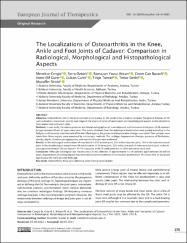| dc.contributor.author | Cengiz, Menekşe | |
| dc.contributor.author | Öztürk, Serra | |
| dc.contributor.author | Arıcan, Ramazan Yavuz | |
| dc.contributor.author | Bacanlı, Ceren Can | |
| dc.contributor.author | Gürer, Elif İnanç | |
| dc.contributor.author | Gürer, Gülcan | |
| dc.contributor.author | Tuncer, Tiraje | |
| dc.contributor.author | Sindel, Timur | |
| dc.contributor.author | Sindel, Muzaffer | |
| dc.date.accessioned | 2023-07-14T11:12:54Z | |
| dc.date.available | 2023-07-14T11:12:54Z | |
| dc.date.issued | 2022 | en_US |
| dc.identifier.issn | 2564-7784 / 2564-704 | |
| dc.identifier.uri | https://doi.org/10.58600/eurjther-28-4-0085 | |
| dc.identifier.uri | https://hdl.handle.net/20.500.12462/13212 | |
| dc.description | Arıcan, Ramazan Yavuz (Balikesir Author) | en_US |
| dc.description.abstract | Objective: Osteoarthritis (OA) is the most common joint disease. In this study it was aimed to compare the general features of OA
such as location, placement, severity and shape of the lesions in terms of radiological and morphological aspects and to determine
their relationship with each other.
Methods: In our study, the antero-posterior and lateral radiographies of knee talocrural and transverse tarsal joints of 20 cadavers
by age between 30 and 50 years were taken. The results obtained from the radiological examination were graded according to the
Kellgren and Lawrence scale. For each of the identified regions, the presence of degenerative changes was noted. Then samples were
taken from these regions were examined by microscopic methods. The cartilage degeneration changes, presence of fibrillations,
density, depth, chondrocyte aggregation, and necrotic changes were evaluated.
Results: In the radiological examination OA was found in 35% in knee joint, 25% in the talocrural joint, 15% in the transverse tarsal
joint. In the morphological examination OA was found in 31.5% knee joint, 25% ankle joint and 5% transverse tarsal joint. In the microscopic examination OA was found in 94.7% knee joint, in 94.7% ankle joint and in 100% transverse tarsal joint.
Conclusion: Although radiological and macroscopic OA was detected in approximately 1/3 of cadavers aged between 30 and 50
years, degeneration of varying degrees was detected in all joints examined in microscopic examination. This shows that an advanced
age disease OA, starts at a very early age. | en_US |
| dc.description.sponsorship | Akdeniz University 2008.02.0122.002 | en_US |
| dc.language.iso | eng | en_US |
| dc.publisher | Pera Yayıncılık Hizmetleri | en_US |
| dc.relation.isversionof | 10.58600/eurjther-28-4-0085 | en_US |
| dc.rights | info:eu-repo/semantics/openAccess | en_US |
| dc.subject | Osteoarthritis | en_US |
| dc.subject | Knee Joint | en_US |
| dc.subject | Talocrural Joint | en_US |
| dc.subject | Transverse Tarsal Joint | en_US |
| dc.title | The localizations of osteoarthritis in the knee, ankle and foot joints of cadaver: Comparison in radiological, morphological and histopathological aspects | en_US |
| dc.type | article | en_US |
| dc.relation.journal | European Journal of Therapeutics | en_US |
| dc.contributor.department | Sağlık Bilimleri Fakültesi | en_US |
| dc.contributor.authorID | 0000-0003-2549-7941 | en_US |
| dc.contributor.authorID | 0000-0003-4044-0652 | en_US |
| dc.contributor.authorID | 0000-0002-6594-1325 | en_US |
| dc.contributor.authorID | 0000-0001-7668-1103 | en_US |
| dc.contributor.authorID | 0000-0001-8287-2264 | en_US |
| dc.contributor.authorID | 0000-0003-1002-0059 | en_US |
| dc.identifier.volume | 28 | en_US |
| dc.identifier.issue | 4 | en_US |
| dc.identifier.startpage | 270 | en_US |
| dc.identifier.endpage | 278 | en_US |
| dc.relation.publicationcategory | Makale - Uluslararası Hakemli Dergi - Kurum Öğretim Elemanı | en_US |


















